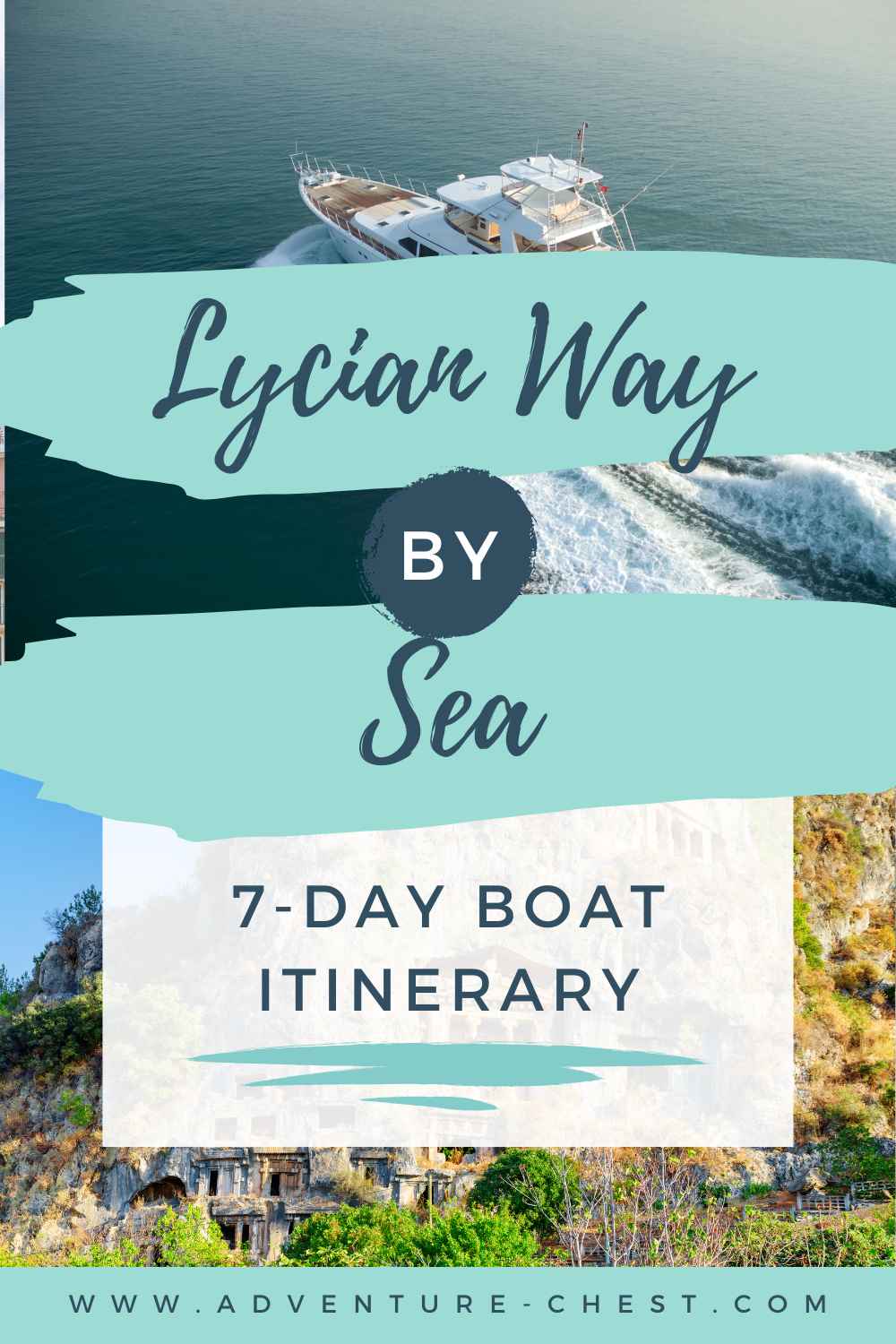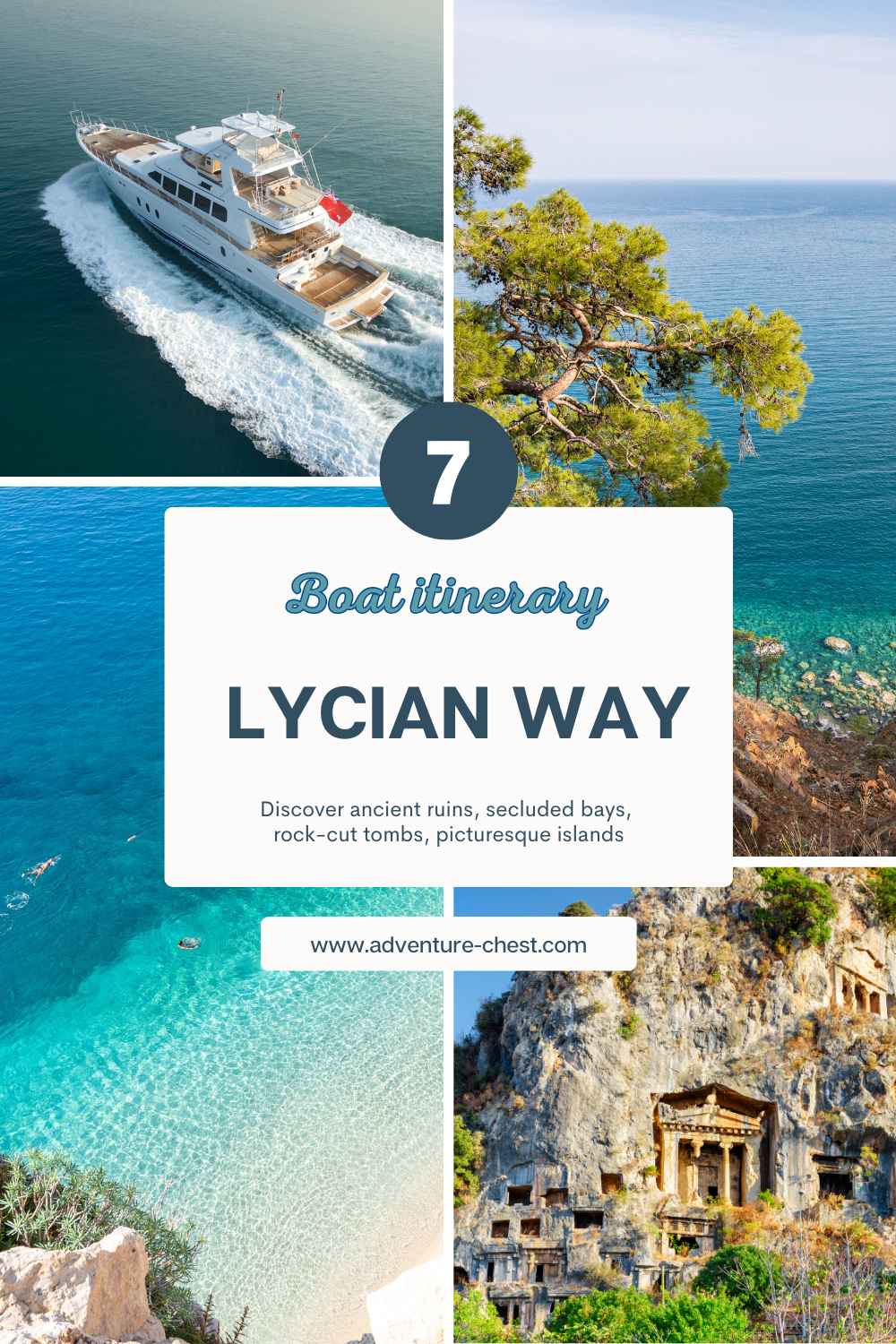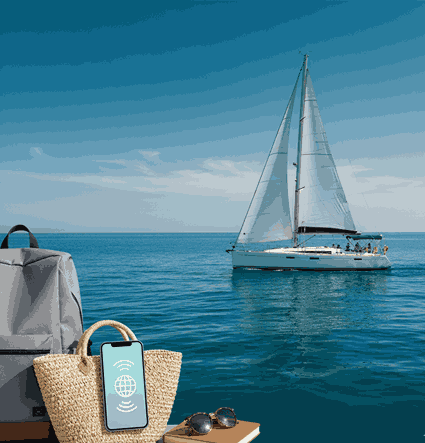The Lycian Way is probably the most scenic hiking route in Turkey, stretching over 500 km / 300 mi. But for those who want to experience its ancient ruins, dramatic cliffs, and hidden bays without long treks, boat exploration is the perfect alternative.
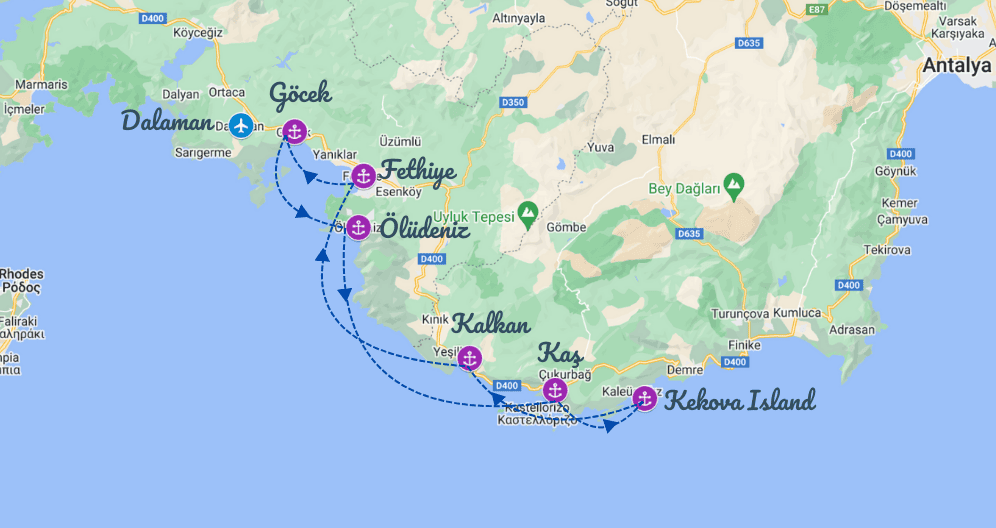
This 7-day route from Fethiye to Kekova and back covers the highlights — sunken cities, medieval castles, and pristine anchorages — while allowing the freedom to move at your own pace. This itinerary of Lycian Way by sea balances historical exploration with leisurely sailing, ensuring each stop offers something worth stepping ashore for.
Day 1: Fethiye → Göcek
The journey begins in Fethiye, a lively harbor town and the starting point for many yachting adventures along the Lycian Coast. After provisioning and a final check of the yacht, set sail for Göcek, a short 1.5 to 2-hour cruise northwest. The route passes through calm, protected waters, making it an easy first leg, ideal for settling into life on board.
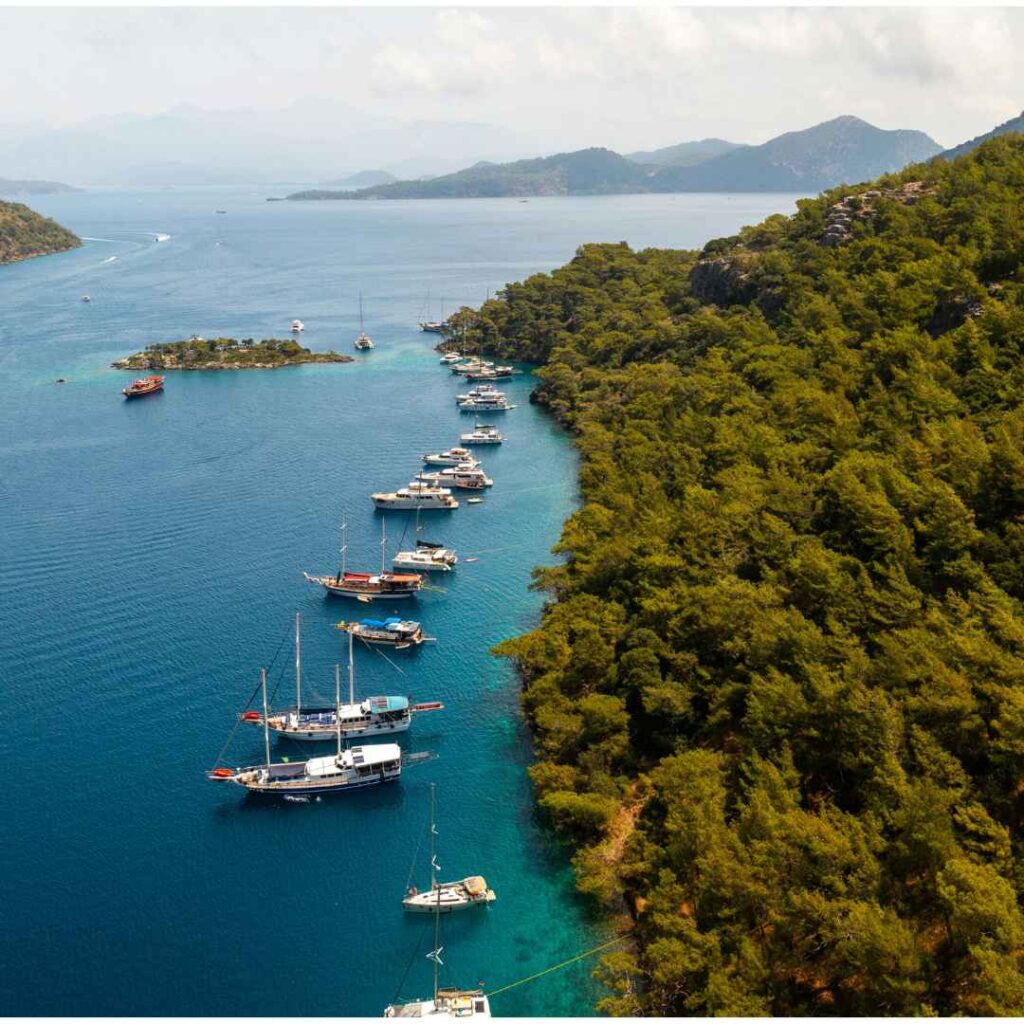
Göcek is more than just a stop—it’s the yachting capital of this coastline. With 6 marinas and world-class facilities, it has a sailing culture that attracts captains from across the Mediterranean. But beyond the marinas, Göcek Bay is a maze of forested islands and quiet anchorages, perfect for a relaxed afternoon swim.
Consider mooring in one of the sheltered bays—like Boynuzbükü or Sarsala—for a more secluded overnight stay, or dock at a marina for an evening in town, where waterfront restaurants serve freshly caught seafood paired with local wines.
Day 2: Göcek → Ölüdeniz
Leaving Göcek, sail southeast for about 2 hours along a coastline of forested hills and hidden bays before reaching Ölüdeniz, home to the Blue Lagoon — Turkey’s most photographed spot. Enclosed by a narrow sandbar, its still, turquoise waters make it one of the most striking anchorages on the Lycian Coast. While private yachts aren’t allowed inside the lagoon, you can drop anchor just outside and take the tender in for a swim.
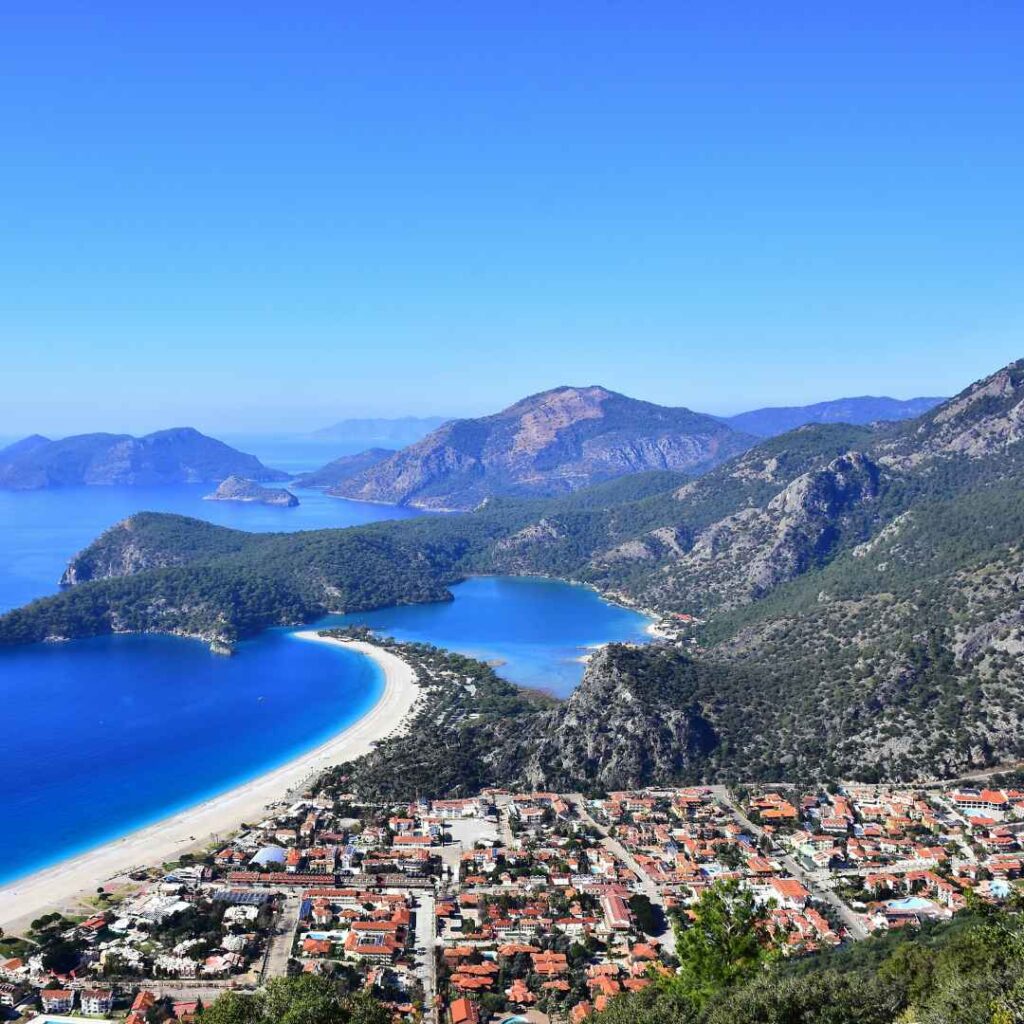
For a change of perspective, paragliding from Babadağ Mountain (1,960m / 6430 ft) offers a bird’s-eye view of the entire coastline. As one of the world’s top paragliding sites, the descent provides uninterrupted panoramas, with a landing directly on Ölüdeniz Beach.
In the late afternoon, continue a short sail to Gemiler Island, an uninhabited islet scattered with Byzantine ruins. Believed to have ties to Saint Nicholas, the island’s ancient churches and stone pathways make for an atmospheric sunset walk. Drop anchor just offshore for a quiet overnight stay, with calm waters sheltered from the open sea.
Day 3: Ölüdeniz → Kaş
Leaving Ölüdeniz behind, you’ll have a 4-5 hour sail southwest along the Lycian coast, passing some of the most striking spots on the route. First up is the Blue Lagoon, which you’ve already seen from the anchorage. While yachts can’t enter the lagoon itself, the surrounding waters are just as stunning, and you’ll get a final look at its vivid turquoise color as you sail past.
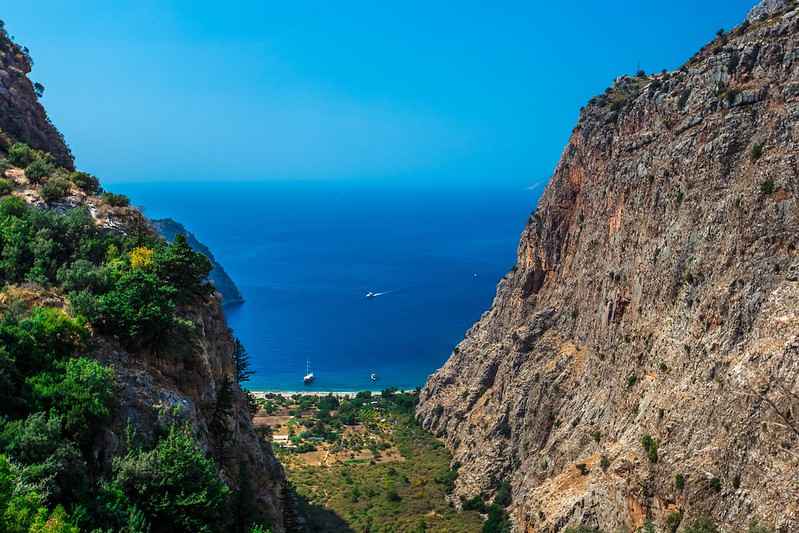
A little further along, you’ll pass the sheer cliffs of Butterfly Valley, rising over 350 meters above the sea. This dramatic canyon is famous for its seasonal population of Jersey tiger butterflies, but what really stands out is the scenery — lush green slopes wedged between rugged rock faces, all leading down to a narrow beach. You’ll spot day-trip boats moored outside the bay, but the valley itself remains quiet beyond the shore.
From here, the coastline becomes wilder, with steep headlands and hidden coves that are hard to reach except by boat. Keep an eye on the water — sea turtles are often seen gliding just beneath the surface, especially near the inlets where they feed. And if you’re lucky, you might spot dolphins in the deeper waters, sometimes riding the waves alongside passing boats before disappearing back into the open sea.
Midway, you’ll navigate past the rugged headlands of Seven Capes (Yedi Burunlar), where the winds often pick up, making for an exciting stretch of sailing. As you approach Kaş, the Greek island of Kastellorizo (Meis) comes into view, adding to the stunning seascape.
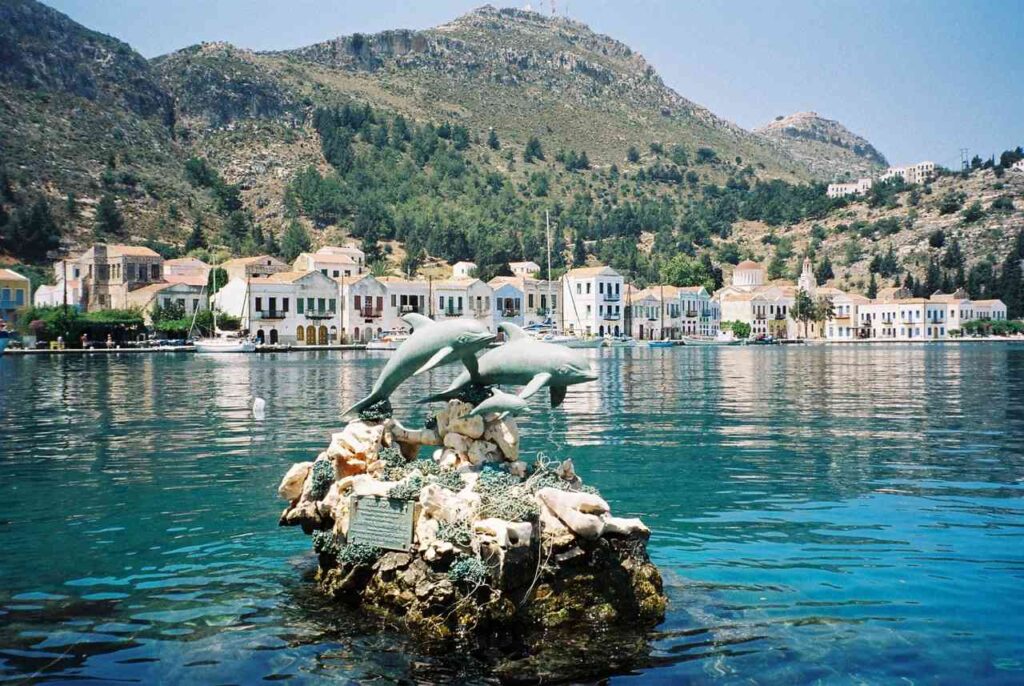
Once in Kaş, you can moor at the marina or drop anchor in the bay. The waterfront is lined with cafés and restaurants, while the old town’s narrow streets lead to ancient Lycian tombs and a beautifully preserved amphitheater with sweeping sea views.
Day 4: Kaş → Kekova
Departing Kaş, you have the option to take a short detour inland to explore Saklıkent Canyon, a 300-meter-deep gorge where you can walk through cool waters between towering rock walls. If you prefer to stay coastal, Kaputaş Beach, often called Turkey’s most beautiful beach, lies just east of Kaş. Its golden sand and turquoise water make it an ideal spot for a swim before continuing. Further along, Patara Beach, the longest stretch of sand on the Turkish Riviera, is perfect for another stop. Nearby, the ruins of Patara, the Lycian capital and the birthplace of St. Nicholas, are worth exploring.
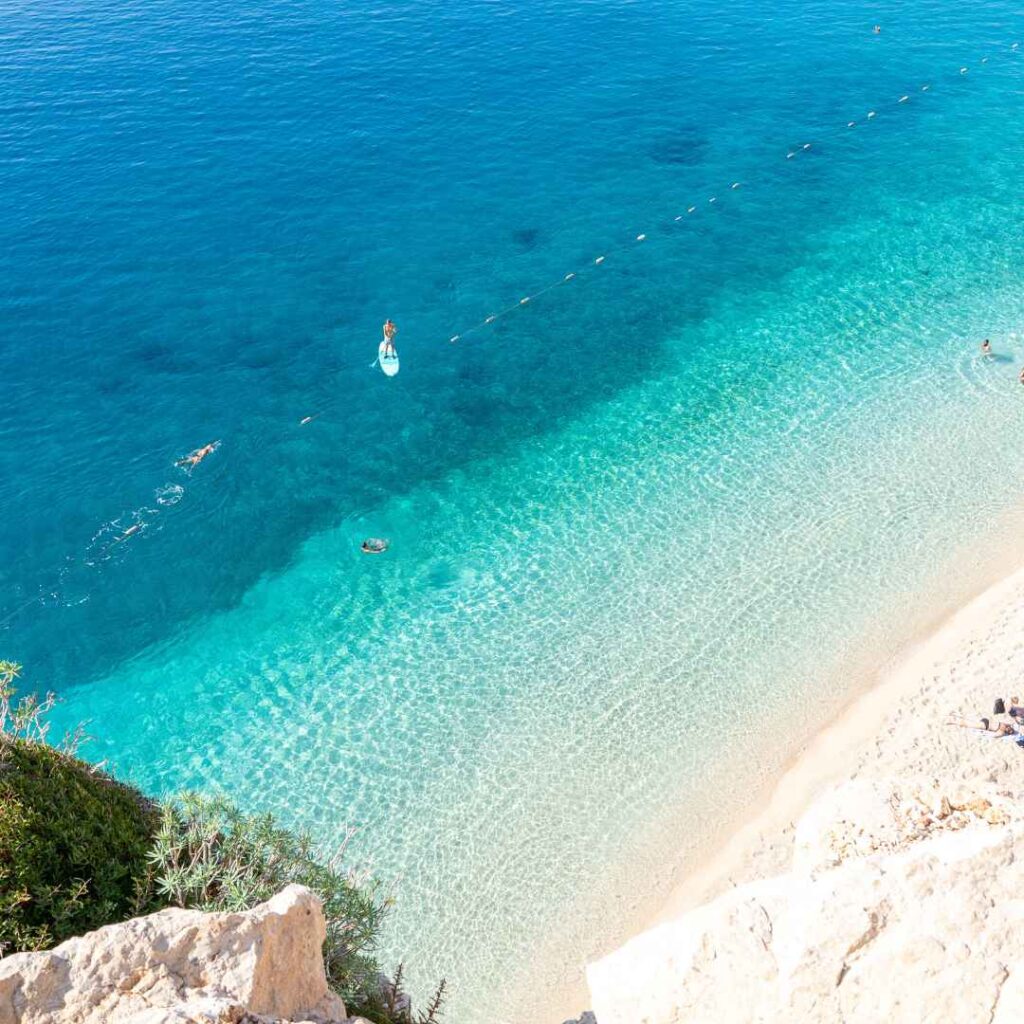
Sailing onward for 2 hours, you’ll reach Kekova, an island with an extraordinary sunken city. Once a thriving Lycian settlement, much of it slipped underwater after a 2nd-century AD earthquake. You can snorkel or take a dinghy over the submerged ruins, where ancient walls and staircases disappear beneath the sea.
Across from Kekova, you can dock near Demre, originally known as Myra, founded around 1000 BC. The town features Lycian rock-cut tombs and the Church of St. Nicholas, a significant pilgrimage site. End the day anchored in Kekova’s tranquil waters, surrounded by history both above and below the surface.
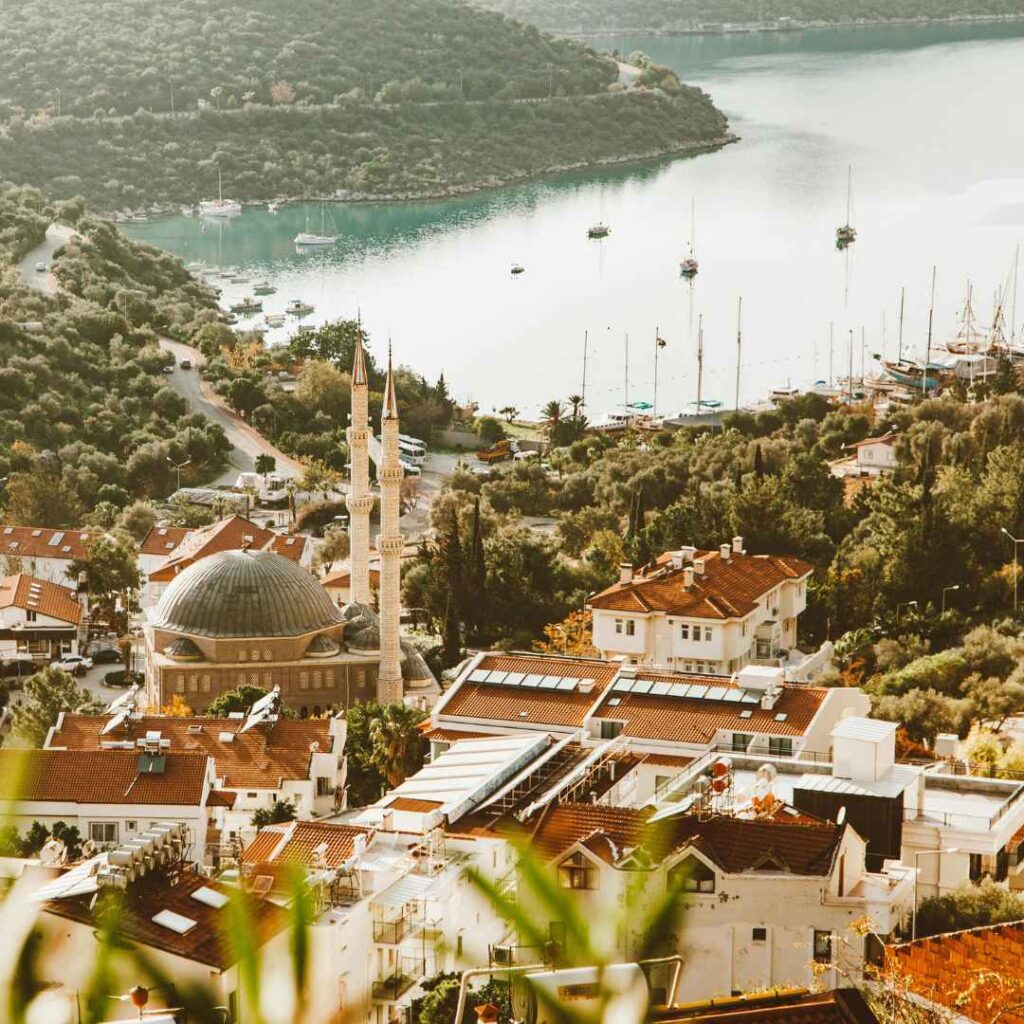
Day 5: Kekova → Kalkan
The journey back toward Fethiye starts with a 4-hour sail from Kekova to Kalkan. This leg follows the same route that Lycian traders and pirates once navigated, skimming past ancient ruins, sea caves, and rugged headlands that still bear traces of their presence.
As the yacht moves westward, it passes the entrance to Aperlai Bay, where the half-submerged remains of an old Lycian settlement mirror the sunken ruins of Kekova. The coastline here is marked by steep limestone cliffs and narrow inlets, a topography that resembles parts of Italy’s Amalfi Coast but with a distinctly Anatolian character.
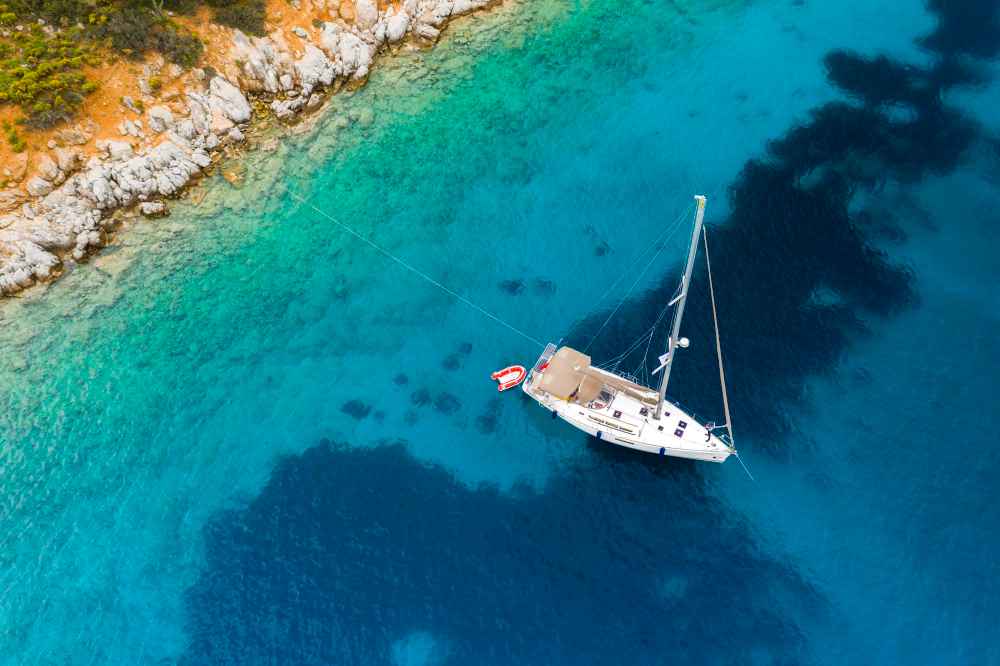
Approaching Kalkan, the sea deepens into a rich cobalt blue, a sign of underwater canyons formed by centuries of tectonic shifts. This once-sleepy fishing village became an important port for British traders in the 19th century, exporting almonds, charcoal, and sea sponges. Today, its whitewashed houses cascade down the hillsides, framed by bougainvillea and offering a view of the bay’s natural amphitheater.
For those interested in history, a short trip inland leads to Xanthos, the former Lycian capital and a UNESCO-listed site. Alternatively, divers and snorkelers can explore the underwater caves near Güvercinlik, where the clarity of the water reveals intricate rock formations and marine life thriving in the depths.
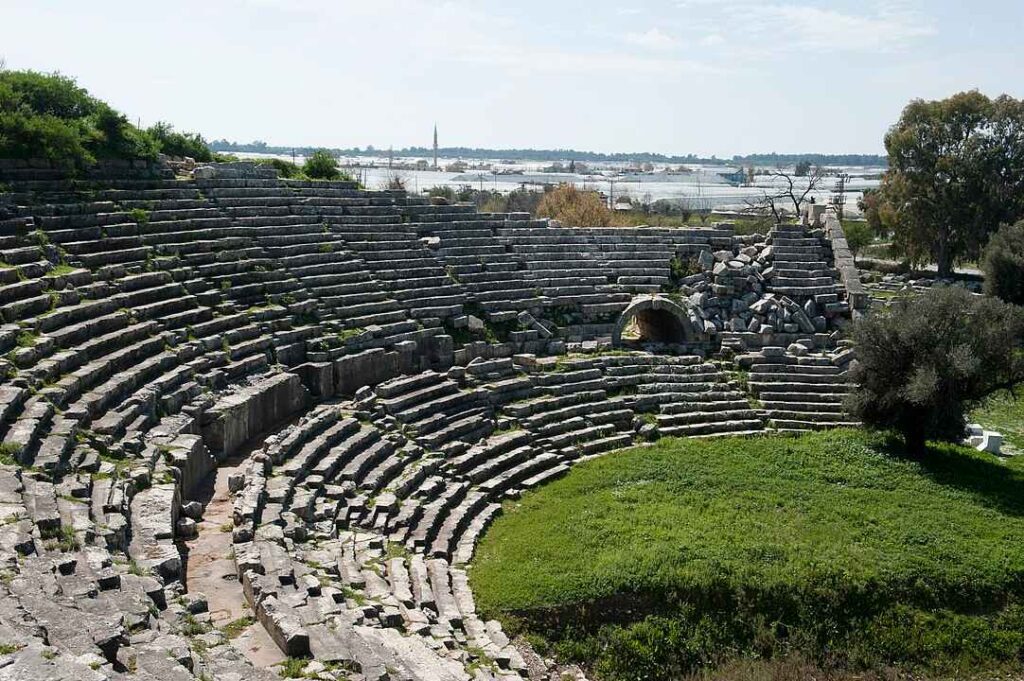
By evening, the harbor fills with an eclectic mix of vessels—from traditional gulets to sleek motor yachts—while the scent of grilled seafood drifts through the narrow streets. Kalkan’s Ottoman-Greek architecture, combined with its sloping alleyways and hidden courtyards, gives it an almost Tuscan feel, but with unmistakable Eastern Mediterranean influences.
Day 6: Kalkan → Fethiye
The return journey to Fethiye takes approximately six hours, tracing the coast past secluded bays, forested slopes, and historic landmarks that have guided sailors for centuries.
Leaving Kalkan, you will sail west past Firnaz Bay, a quiet anchorage known for its crystal-clear waters. Further along, Babadağ comes back into view—this towering peak, already familiar from Ölüdeniz, has long served as a landmark for sailors navigating these waters. Below it, the coastline features a series of small, sheltered coves, offering opportunities for a final swim before entering busier waters.
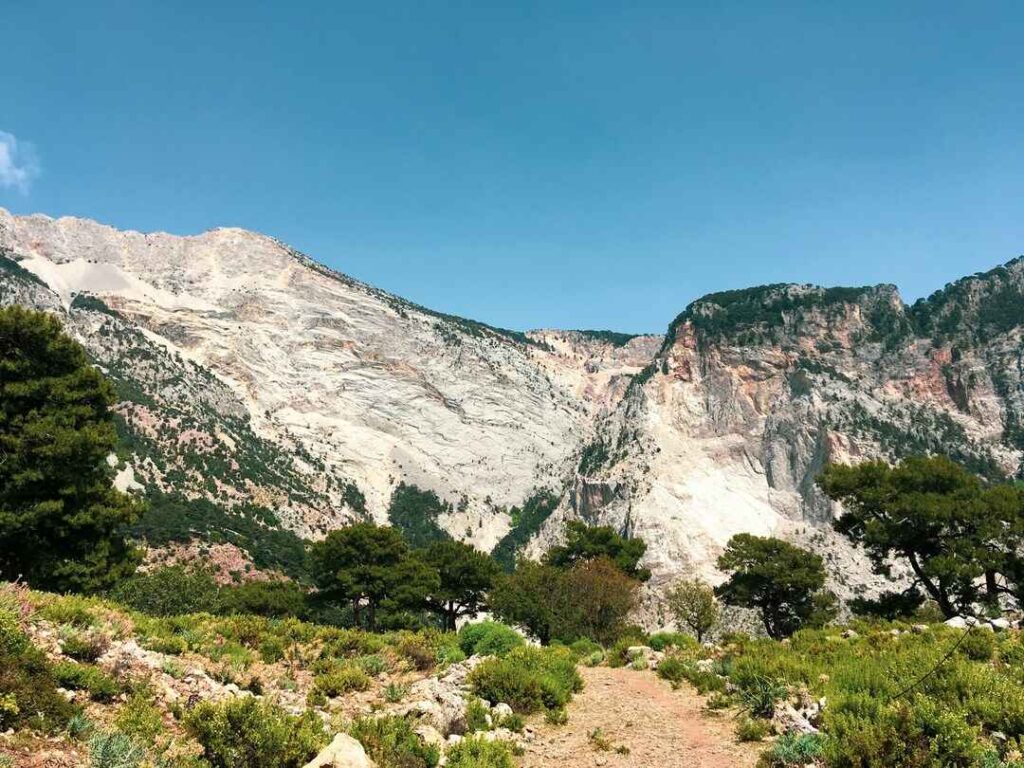
As you approach Fethiye, the rugged cliffs gradually give way to pine-covered hills, marking the entrance to one of Turkey’s most protected natural harbors. A last stop at Turunç Pınarı or Samanlık Bay provides a peaceful pause before returning to port.
By late afternoon, you will arrive in Fethiye, where the journey at sea comes to a close. In the evening, a visit to Fethiye’s lively fish market offers a quintessential local experience—select fresh seafood from the market stalls and have it cooked to order at one of the surrounding restaurants, making for a perfect end to the sea voyage.
Day 7: Fethiye
Even with a few hours left before departure, there’s still time to explore Fethiye beyond the familiar waterfront. Rather than revisiting the marina or old town, consider lesser-known sites that offer a more distinctive farewell to the region.
For those interested in archaeology, Tlos provides a striking combination of Lycian, Roman, and Ottoman ruins, set against the dramatic backdrop of Akdağ Mountain. Unlike the rock tombs overlooking Fethiye, Tlos features a hilltop acropolis, a well-preserved theater, and an ancient stadium, making it one of the region’s most layered historical sites.
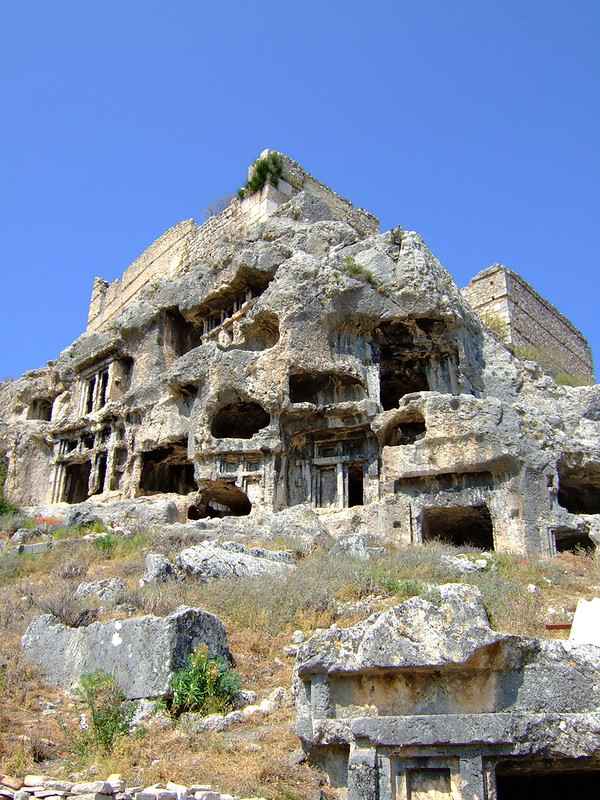
If you prefer a nature-focused experience, Af Kule Monastery offers a scenic yet quiet alternative. This cliffside ruin, perched high above the sea, requires a short but steep hike through pine forests, leading to breathtaking views of the Mediterranean. The monastery’s remote location makes it a peaceful escape before heading back to modern life.
For a final experience on the water, rent a kayak or paddleboard in Aksazlar Bay or Boncuklu Cove, where the coastline remains unspoiled. These sheltered bays, just a short distance from Fethiye, provide a last opportunity to glide through the calm waters, past sea caves, and rocky outcrops rarely seen by visitors.
Highlights of the Voyage
- Fethiye
- Fish Market
- Kadyanda (Lycian-Roman city)
- Kayaköy (abandoned Greek village)
- Tlos (Lycian-Roman-Ottoman ruins)
- Af Kule Monastery (cliffside ruins)
- Göcek
- Boynuzbükü Bay
- Sarsala Bay
- Ölüdeniz
- Blue Lagoon
- Babadağ Mountain
- Gemiler Island (Byzantine ruins, linked to St. Nicholas)
- Kaş
- Amphitheater (sea view)
- Firnaz Bay (secluded anchorage)
- Kaputaş Beach (turquoise water, golden sand)
- Greek island of Kastellorizo (Meis)
- Kekova
- Sunken Lycian city (underwater ruins)
- Aperlai Bay (half-submerged Lycian ruins)
- Demre (formerly Myra)
- Church of St. Nicholas (pilgrimage site)
- Kalkan
- Xanthos
- Seven Capes (Yedi Burunlar) (rugged sailing stretch)
- Firnaz Bay
Lycian Way by Sea Map
Navigation Tips for Lycian Coastline
| Wind & Weather Patterns | Afternoon meltemi winds (northwest) are common in summer, especially around the Seven Capes (Yedi Burunlar), where gusts accelerate through headlands—plan to pass this section in the morning when winds are lighter. |
| Sea Conditions | The stretch between Kaş and Kekova is well-protected, but between Kalkan and Fethiye, expect sudden wind shifts and occasional short, choppy waves due to the way the coastline funnels gusts—reef sails accordingly. |
| Navigation Hazards | Unmarked underwater ruins around Kekova can be deceptive, especially in low visibility; approach slowly and avoid straying outside designated anchorage zones to prevent grounding. |
| Anchoring & Holding | Many bays, such as Sarsala and Boynuzbükü, have mud and sand bottoms offering excellent holding, but in exposed anchorages like Butterfly Valley, the seabed is rocky—use a trip line to prevent anchor fouling. |
| Mooring Considerations | Kalkan and Kaş marinas fill up quickly in peak season (July-August); secure a berth in advance or be prepared to med-moor along the quay with long stern lines. |
| Currents & Tides | Though tides in the Mediterranean are minimal, expect noticeable currents at the entrance to Fethiye Bay, especially when strong winds push water into the gulf—adjust approach speed accordingly. |
| Fuel & Water Stops | The last reliable refueling point before Kekova is in Kaş; fuel stations in Göcek and Fethiye have the best availability, but queues form in late afternoon—refuel in the morning to avoid delays. |
| Sheltered Anchorages | If unexpected strong winds pick up, Göcek Bay offers the best all-weather shelter with numerous protected coves, while Kalkan has limited protection in heavy swell—consider rerouting to Kaş if conditions worsen. |
| Restricted & Protected Areas | Boats cannot enter the inner part of Ölüdeniz’s Blue Lagoon; also, anchoring is restricted over Kekova’s sunken city — use a dinghy or kayak for close-up exploration. |
| Local Traffic & Ferries | Watch for high-speed ferries running between Kaş and Kastellorizo (Meis), which create a significant wake, especially near the marina entrance — time docking maneuvers accordingly. |

